It was super fun to be interviewed and photographed by Portland Real Producers Magazine. Check out the link to the full article below to find out what they asked us!
Category: General
General information
How to Create a “Show Ready” Home
The spring market is in full swing! With a strong market and some uncertainty about how long the Portland real estate values will stay as robust, there are a lot of homeowners considering selling. Seller’s often feel overwhelmed with long to-do lists and don’t know quite where to begin. Hopefully, the following advice will help you stay focused, motivated and guide you in getting your home “show ready”.
Remember, not everyone will love your home’s décor, but don’t take it personally because it’s almost certain that you wouldn’t like theirs either. Think of your home as a product in a marketing campaign. Staging is about creating a “show ready” home that has wide appeal.
Here are a few tips that will get you started:
-
First Impression
- Curb appeal – The initial perception of your home sets the mental tone of the viewers. If
 they drive up to your home and the landscaping is nicely manicured, the walkway is clean, there are welcoming potted plants at the front door, the door itself is inviting, the windows are clean, the exterior paint is in great condition, perhaps there are even a couple of nice chairs or a porch swing (if applicable), it will create a positive first impression. Remember you are just trying to set the stage that tells the potential buyer this is a quality home and a lot of care has gone into it.
they drive up to your home and the landscaping is nicely manicured, the walkway is clean, there are welcoming potted plants at the front door, the door itself is inviting, the windows are clean, the exterior paint is in great condition, perhaps there are even a couple of nice chairs or a porch swing (if applicable), it will create a positive first impression. Remember you are just trying to set the stage that tells the potential buyer this is a quality home and a lot of care has gone into it.
- Interior – The main entry room, whether it’s a foyer, living room or something else, is equally

 important for building on that first impression. Take extra care to make this space as warm and inviting as possible. Also, notice the scent of your home when you enter the front door (this is especially important if you have a pet). A nice scent helps create an inviting atmosphere that works on a subconscious level with the prospective buyer. Nothing will dissuade a buyer faster than “house-a-tosis”. It’s important to correct the odor instead of covering it up if it’s due to mold or carpet damage caused by pets, etc. Stay away from heavy perfume scents or anything overbearing. Freshly cut flowers in the entry and throughout the house can provide some natural scent and add extra beauty and warmth to your home.
important for building on that first impression. Take extra care to make this space as warm and inviting as possible. Also, notice the scent of your home when you enter the front door (this is especially important if you have a pet). A nice scent helps create an inviting atmosphere that works on a subconscious level with the prospective buyer. Nothing will dissuade a buyer faster than “house-a-tosis”. It’s important to correct the odor instead of covering it up if it’s due to mold or carpet damage caused by pets, etc. Stay away from heavy perfume scents or anything overbearing. Freshly cut flowers in the entry and throughout the house can provide some natural scent and add extra beauty and warmth to your home.
-
The Nitty-Gritty
- Clutter – Remember that “less is more” in preparing your home for sale. You may love your
 collection of widgets, but a prospective buyer might be distracted by all of the clutter. You want the buyer to look carefully at your home, not your possessions. A good rule-of-thumb is if it’s smaller than a grapefruit, pack it up. Remove any countertop appliances that are not built-in. Your furniture and accessories should help them get a sense of the space in the room and allow them to envision moving their own things in. Consider removing your personal photographs and memorabilia. You want buyers to envision creating their own memories in your home, not distracted by yours. Closets, basements, attics and garages should be clean, well-lit and organized. Ample storage is a common buyer request so make yours appear as spacious as possible. Do not make the mistake of moving the clutter from the living spaces to these areas. A temporary storage unit might be well worth the investment while your home is on the market. Plus you are moving, so consider the packing process underway!
collection of widgets, but a prospective buyer might be distracted by all of the clutter. You want the buyer to look carefully at your home, not your possessions. A good rule-of-thumb is if it’s smaller than a grapefruit, pack it up. Remove any countertop appliances that are not built-in. Your furniture and accessories should help them get a sense of the space in the room and allow them to envision moving their own things in. Consider removing your personal photographs and memorabilia. You want buyers to envision creating their own memories in your home, not distracted by yours. Closets, basements, attics and garages should be clean, well-lit and organized. Ample storage is a common buyer request so make yours appear as spacious as possible. Do not make the mistake of moving the clutter from the living spaces to these areas. A temporary storage unit might be well worth the investment while your home is on the market. Plus you are moving, so consider the packing process underway!
- Repair – Go through each room with a very critical eye and see what might catch prospective buyers’ attention.
 Look at every surface: floors, walls, doors, windows, ceilings, built-in furniture, etc. Also make sure that all of your home’s systems are in good working condition (electrical, mechanical & plumbing).
Look at every surface: floors, walls, doors, windows, ceilings, built-in furniture, etc. Also make sure that all of your home’s systems are in good working condition (electrical, mechanical & plumbing).
- Improve – Remember
 you are trying to appeal to the masses so if your home is decorated in a way that only a select few can appreciate, change it. Don’t remodel – it’s amazing what a fresh coat of neutral paint and simplifying and rearranging your current possessions will do. A few new accessories like fluffy new bath towels, accent pillows and fresh flowers might just add the finishing touches. Also, if your house is on the dark side then purchasing some extra lamps or using LED bulbs will be money well spent.
you are trying to appeal to the masses so if your home is decorated in a way that only a select few can appreciate, change it. Don’t remodel – it’s amazing what a fresh coat of neutral paint and simplifying and rearranging your current possessions will do. A few new accessories like fluffy new bath towels, accent pillows and fresh flowers might just add the finishing touches. Also, if your house is on the dark side then purchasing some extra lamps or using LED bulbs will be money well spent.
- Clean – Hire a professional cleaning company to do a thorough cleaning after you have completed
 all the clutter removal, repairs, and improvements. This is money well spent and will put the final polish on your “show ready” home. And don’t forget the windows!
all the clutter removal, repairs, and improvements. This is money well spent and will put the final polish on your “show ready” home. And don’t forget the windows!
-
It’s Show Time!


- Pets – Make sure there is no trace of your pet (leash, dish, litter box, bed, etc.) It’s a safe bet that your home will appeal to more people when it’s pet free than not.
- Children – Ideally, you and the children should not be home during a showing. It’s also important to make sure that toys aren’t strewn throughout the house, for two reasons: one is to avoid the clutter factor, and two is being responsible for a buyer tripping on a roller-skate.
- Daily preparation – You can’t be sure when the phone will ring and a realtor will say “we’re right around the corner!” It’s important to keep the house in “show ready” condition at all times so you simply do minor touches before you head out the door.
The following check-list will make sure your home is “show ready”.
Showing Check-List:
Kitchen:
__ Floors swept and mopped
__ Appliances cleaned
__ Counters clean and free of clutter
__ Fresh flowers or scent (vanilla or cinnamon)
Bathrooms:
__ Mirrors and glass cleaned
__ Bathrooms cleaned and smell fresh
__ Tubs and sinks cleaned
__ Fixtures cleaned and polished
__ Toilet seat down
__ Fresh towels neatly arranged
Bedrooms:
__ Beds made with pillows arranged neatly
__ Clothing and clutter put away
Living Areas:
__ Sofa and chair cushions fluffed
__ Pillows arranged neatly
__ Rooms tidy and uncluttered
Laundry Room:
__ Clean and tidy
__ Clothes picked up
__ Cleaning products put away
Overall Interior:
__ Floors mopped and vacuumed
__ Surfaces dusted
__ Windows cleaned
__ All lights on
__ No odors (nice scent at entrance)
__ Interior doors open
__ Curtains open
__ Soft music playing
__ Fresh cut flowers
__ House at comfortable temperature
__ For extra safety, secure all valuables & medications
Garage:
__ Garage swept
__ Workbenches cleaned and uncluttered
__ Garage door closed
__ No cars in garage, driveway or curb (if possible)
Exterior:
__ Front entry cleaned and uncluttered
__ Yard and exterior cleaned and uncluttered
__ Animal droppings in yard picked up
__ Leaves etc. in yard picked
It’s Time for a Fresh Start – Inhabit’s Spring 2019 Newsletter
Inhabit’s spring newsletter is all about mixing things up and starting fresh. You’ll find it here!
Celebrating 5 Years Inhabiting our Flagship Office in SE Portland
Celebrating 5 Years Inhabiting our Flagship Office in SE Portland
5 years ago, Inhabit Real Estate decided to put down stakes on SE Division Street at the epicenter of it all. It was during a time that the neighborhood was experiencing tremendous growth and the landscape of the street was transforming a little too rapidly for some. A sea of mixed-use, 4-story apartment buildings sprung up between existing shops and restaurants. The renewed energy brought in some anchor tenants that literally transformed the entire neighborhood vibe. Today, it’s an area that literally buzzes with energy. The street is lined with noteworthy eateries and was dubbed one of the “10 Best Foodie Streets in America” by Food and Wine Magazine. The restaurants, unique shopping, and local vibe make it a worthy destination in Portland. We happily claim our spot nestled between the Whiskey Soda Lounge and Bula Kava House at 31st and Division.
 As a small, Portland-based company, our goal was to celebrate everything local in our design. We partnered with Maven Interiors, an award-winning local design company and Christopher McDonald (our good friend and amazing carpenter/ contractor) to do the build-out. We challenged the design team to create something that was unique, sustainable and had a hand-crafted feel. We wanted our storefront to add to the streetscape and our presence embraced by the community.
As a small, Portland-based company, our goal was to celebrate everything local in our design. We partnered with Maven Interiors, an award-winning local design company and Christopher McDonald (our good friend and amazing carpenter/ contractor) to do the build-out. We challenged the design team to create something that was unique, sustainable and had a hand-crafted feel. We wanted our storefront to add to the streetscape and our presence embraced by the community.
Here’s a brief tour of some of the “local” aspects of our office…
One of the first things you will notice as soon as you walk in the office is a huge mural of an abstract Portland map that we commissioned local artist Jerry Inscoe to create for us. The red peg indicates “you are here”.
We looked for opportunities to infuse art in unexpected ways. Our interior doors, for example, became blank canvases. We asked Jerry Inscoe to collaborate with local artist Jennifer Mercede to bring our doors to life in an otherwise uninspired corridor. Jerry airbrushed abstract backgrounds and Jennifer painted things reminiscent of Portland (Doug firs, bubbler fountains, bicycles, etc) in a whimsical doodle fashion on top. The contrasting styles of the artists resulted in one-of-a-kind creations.
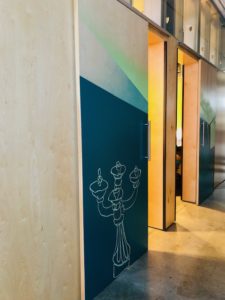


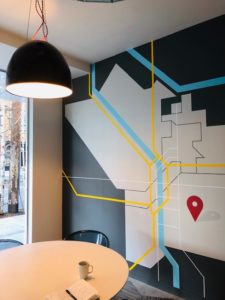 We turned to Portland’s own Schoolhouse Electric for all of our office pendants lights and Pratt and Larson Tile for our handmade kitchen backsplash.
We turned to Portland’s own Schoolhouse Electric for all of our office pendants lights and Pratt and Larson Tile for our handmade kitchen backsplash.
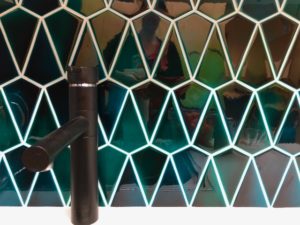

The bathroom wallpaper is the work of local designers at MAKELIKE, a graphic design collective in SE Portland. We loved continuing the unexpected whimsy in the loo.
All of our office partitions and workstations were custom designed by Maven Interiors and hand built by Chris McDonald. The materials used are untraditional, just like us. We are different by design.



The next time you find yourself on SE Division Street, please stop by for a tour and a cup of coffee. We would be happy to make your acquaintance.
In Which I Call B.S. on a Recent HousingWire Story
Did you see the headline from last week? “It costs more to own a home than to rent one in every U.S. state.” For a link to the article, click here.
The story talks about how using US Census Bureau data, CNBC was able to compare the median cost of renting a home to the median cost of owning a home.
Remember what a median is? A median is “the value or quantity lying at the midpoint of a frequency distribution of observed values or quantities.” In other words, if you have 1,001 houses, exactly 500 will cost more and 500 will cost less.
And this is where the methodology is screwed up. RentCafe took the same data that CNBC used and figured out that in the US, there are 73% more apartments rented than houses. And the Terner Center at Berkley took that same data and determined that “Today, single-family detached homes make up more than 62 percent of the housing stock in the United States…” .
So the median rental is way more likely to be an apartment, while the median home that’s owned is way more likely to be a house.
Here’s another way to think of it. Jennifer Lopez has a $28 million home. So she and all the other millionaires who own mansions skew the median cost of home ownership up. But unless
there are a lot of millionaires out there renting apartments for like $2 million a month, it’s a pretty safe bet that median rental doesn’t skew as far north.
If all those numbers make your eyes glaze over, let me frame it one more way. The common
sense way.
The CNBC story implies that in every single state, people who rent out their homes are, on
average, losing money. In other words, we have a country full of generous landlords.
Sorry, that just doesn’t fly.
As a realtor®, it’s important to stay informed. But it’s way more important to think.
Dreaming of a Vacation Property?
 If I told you that you could own a peaceful vacation retreat at an affordable price within a half hour of downtown Portland would you believe me? Believe it or not, it’s true. Within minutes of downtown Portland (and in some cases a stone’s throw), there are hundreds of FLOATING HOMES right in front of our eyes. These unique homes come in all shapes, sizes and prices and deliver a truly peaceful, fun retreat from the day-to-day grind of life.
If I told you that you could own a peaceful vacation retreat at an affordable price within a half hour of downtown Portland would you believe me? Believe it or not, it’s true. Within minutes of downtown Portland (and in some cases a stone’s throw), there are hundreds of FLOATING HOMES right in front of our eyes. These unique homes come in all shapes, sizes and prices and deliver a truly peaceful, fun retreat from the day-to-day grind of life.
Whether it’s on the Willamette, Columbia or Multnomah Channel, there are moorages of all different styles and flavors with a myriad of floating homes enjoying a convenient, peaceful existence right on the water.
With Portland’s explosive growth, dense housing landscape, affordability concerns and emphasis on lifestyle, it’s surprising that these homes aren’t wildly more popular. The cat is certainly out of the bag in our “sister” cities like Seattle and San Francisco where floating homes are often just as much a consideration as land homes for primary residences or second homes.
 As brokers, we hear quite often from our clients the desire to purchase a second property whether it’s at Mt. Hood, Bend or other destinations which could take hours to get to. One of the most important factors when purchasing a second home is convenient access. Taken from first-hand experience, once the honeymoon period is over after purchasing a vacation property, it’s all too easy to talk yourself out of a long drive on a Friday after work to retreat to your vacation home. However, with dozens of floating home moorages within a half hour of Portland, the much-needed escape is only a short drive away.
As brokers, we hear quite often from our clients the desire to purchase a second property whether it’s at Mt. Hood, Bend or other destinations which could take hours to get to. One of the most important factors when purchasing a second home is convenient access. Taken from first-hand experience, once the honeymoon period is over after purchasing a vacation property, it’s all too easy to talk yourself out of a long drive on a Friday after work to retreat to your vacation home. However, with dozens of floating home moorages within a half hour of Portland, the much-needed escape is only a short drive away.
 On top of relaxation, these properties afford fun and entertainment such as swimming, boating, fishing, wildlife observation, kayaking, and unlimited access to waterways, islands, and much more.
On top of relaxation, these properties afford fun and entertainment such as swimming, boating, fishing, wildlife observation, kayaking, and unlimited access to waterways, islands, and much more.
We realize that floating homes may not be for everyone, but we want to bring light to these special properties….especially given the abundance of them within a short drive from Portland. As our town continues to bust at the seams, we predict more buyers will begin to consider them as an option for their primary residence or as an escape from city life.
Currently, during the off-season, there are 36 floating homes for sale on the Portland area waterways ranging in price from $80k – $1.1M (with the median price of $266K). Suprised? I was too when my family and I started looking and decided to buy one on Sauvie Island 2 ½ years ago. It was the best decision we ever made. Our summers and weekends are filled with memories that will last a lifetime. Why wait for a vacation when you can live like you’re on one all the time!
Look on the Bright Side – Inhabit’s Winter 2019 Newsletter
Inhabit’s winter newsletter is chock-full of suggestions to brighten, lighten, and enliven Portland’s dark, wet season. Find it here!
2019 PDX Real Estate Outlook From Inhabit’s Owner Eric Hagstette
It’s 2019! I hope you had a restful holiday season and are as excited about the new year as I am. I find this time of year refreshing as I look ahead. The following is my market outlook for 2019. I was excited to look back on my 2018 predictions and am happy to report that I pretty much nailed it! Our Portland real estate market is very healthy….different, but healthy. We’ve been enjoying solid appreciation since 2012 and our market continues to strengthen the fundamental components required to keep a market healthy and resilient (ie., job growth, buyer qualifications, lending guidelines, availability of financing, desirability, popularity, and so forth). With this being said, the Portland market has changed and we think it is chock-full of opportunity for both our buyer and seller clients.
Inventory
Real estate buzz word #1. This simply means “supply” of housing for sale. Inventory levels determine who has the upper hand (or level hand) in the real estate market. Portland’s historically low inventory has always favored our seller clients; however, as of late 2018, inventory levels rose to a point (approximately 3 months) that has given our buyer clients hope of achieving their dreams of owning real estate. We are excited for our buyer clients and investors and doing our best to encourage them to take advantage of this “correction” or “softening” or “shift”. Call it what you will, we think this is a great time to get into the market or move around within the market.
Interest Rates
Real estate buzz word #2. We’ve been warned for years that rates would be going up and it finally happened. As we all knew, 3-4% long-term interest rates were unsustainable. These low rates were simply a tool (“quantitative easing”) used for economic recovery and stimulation as a result of the “great recession”. We’ve begun the march back to more sustainable rates for real estate financing. While these rates are still at historic lows, we understand the impacts (and discomfort) that rising rates have on real estate prices (they both can’t go up at the same time). Our sources say that we will likely have a couple more rate hikes in 2019 so, again, we’re encouraging our buyer clients to jump in the market before rates creep up more. Interestingly enough, as I write this, rates are at an 8 month low which is stirring up activity for us. On a positive note, there is still ample liquidity and loan programs for real estate financing and qualified buyers. Great lenders paired with skilled real estate negotiators (me) can introduce ways to buy rates down for our buyer clients and lower the barrier into the market.
Price, Value, Affordability
Buzz word(s) #3. Inventory, rates and real estate prices are all tied together. As mentioned, rates and prices don’t normally go up at the same time. It’s no secret that Portland (and many other metro markets) have a huge “affordability” issue. Rising rates and inventory have joined forces to encourage (or force) our seller clients to price their real estate realistically based on these new inventory levels. It is important to look at this from a positive perspective. 2019 sellers have not “missed the market”. Most of our sellers have enjoyed huge gains in appreciation of their holdings since 2012 (or longer). In my humble opinion, if we simply adjust those appreciation averages to account for today’s market conditions, most people would still be more than happy with their rate of return when spread across the years.
Luxury Homes & High-End Market
This market is all over the board. We’re seeing examples of high-end listings sitting on the market. We’re also seeing examples of high-end listings flying off the shelf. Every property has a price and there are still buyers that can and will appreciate high-end luxury homes. Keep in mind, Portland has always been insulated by the famous migration of buyers moving from California, Seattle, New York, and other “jumbo” markets. To these buyers, our “high-end” listings may seem like a bargain. With this said, regardless of the market segment, it is imperative to price real estate competitively.
Condominiums/Attached Townhomes
 While these types of properties continue to grow in popularity in Portland, so does the buying power for condos and townhouses. The recent over-saturation new rental apartments in Portland has softened prices for condos and townhouses. With Portland’s limited land for development (and sprawl) and encouraged density, these properties will remain a player in the market and will “weather” this shift as our population continues to grow and buyers prioritize simplicity and efficiency. In the meantime, this is an outstanding market segment to take advantage of for our buyer and investor clients.
While these types of properties continue to grow in popularity in Portland, so does the buying power for condos and townhouses. The recent over-saturation new rental apartments in Portland has softened prices for condos and townhouses. With Portland’s limited land for development (and sprawl) and encouraged density, these properties will remain a player in the market and will “weather” this shift as our population continues to grow and buyers prioritize simplicity and efficiency. In the meantime, this is an outstanding market segment to take advantage of for our buyer and investor clients.
There you have it….my two cents on the local market for 2019
I strongly believe that these “in between” markets present the greatest opportunities for our clients. Unfortunately, we usually don’t realize these opportunities until they’re gone. While we’re experiencing a market correction, we’re still very bullish in the Portland market. We’ve built the fundamentals of a solid market while our job base and popularity continue to thrive. As “the darling” of the Pacific Northwest, Portland may experience blips like this one; however, the combination of current/future population growth with our Urban Growth Boundary and natural land barriers (to development), we feel we have a recipe for strong upward appreciation over the next 10-year cycle. The long and short of it….we do not think buyers should wait to take advantage of this market. At the same time, we feel like sellers who properly price and present their real estate will have a satisfying outcome. It’s a solid market for both sides! The key component is accepting the change and adapting to it. As usual, if you know of anyone considering buying, selling or investing in real estate, we would be honored to receive your referrals and serve your friends and family with outstanding service.
Mill-50
Eric’s newest project brings 12 new construction homes to the market in March, 2015. These modern, attached homes feature 3 beds/3.5 baths, superbly located at SE 50th & Mill, just off SE Hawthorne.
.jpg)
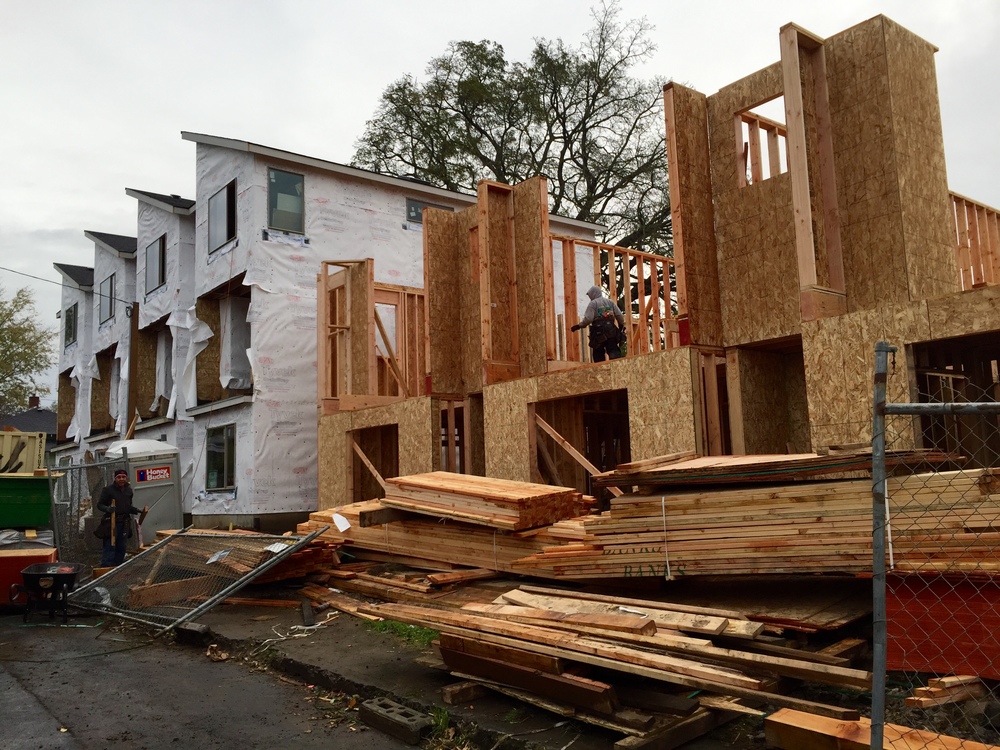


For more information, visit inhabitre.com/mill-50 and contact Eric Hagstette.
To Airbnb or Not to Airbnb?
Portland’s close-in pocket neighborhoods are a perfect market for the AirBnb concept. Many of our clients are taking advantage of this short term rental demand and converting underutilized space to create passive income. We’ve seen this trend grow stronger and stronger as Portland becomes a wildly popular urban, vacation destination.
Here is a recent article Dale came across on oregonlive.com that discusses the city of Portland’s willingness to ease some of it’s restrictions on the short-term rental market laws.
Inhabit office art
 Local artist. Jerry Inscoe, created this amazing abstract map mural of Portland for our conference room wall.
Local artist. Jerry Inscoe, created this amazing abstract map mural of Portland for our conference room wall.
Having fun with floor tiles
Here’s another look into our office design and build-out process. Things are really starting to take shape.
Helicopter View of Richmond Commons
Here are a couple of cool shots taken from an aka unmanned aerial vehicle, aka miniture helicopter, aka drone.
.jpg)
.jpg)
For more information on these townhome style condominiums coming to the market soon, contact Eric Hagstette. eric@inhabitre.com | 503-313-6476
The windows are going in at Richmond Commons
The condominiums at 50th and SE Tibbetts are really taking shape.
For more information about the Richmond Commons condominiums at SE 50th and Tibbetts, contact Eric Hagstette. 503-313-6476 | eric@inhabitre.com
Richmond Commons update
The Richmond Commons condominiums are really starting to take shape this week.
For information on purchasing one of these 12-unit townhome style condominiums, please contact
503-313-6476 | eric@inhabitre.com
Richmond Commons Check-in
Quite the sky over the Richmond Commons project today.
Richmond Commons breaks ground
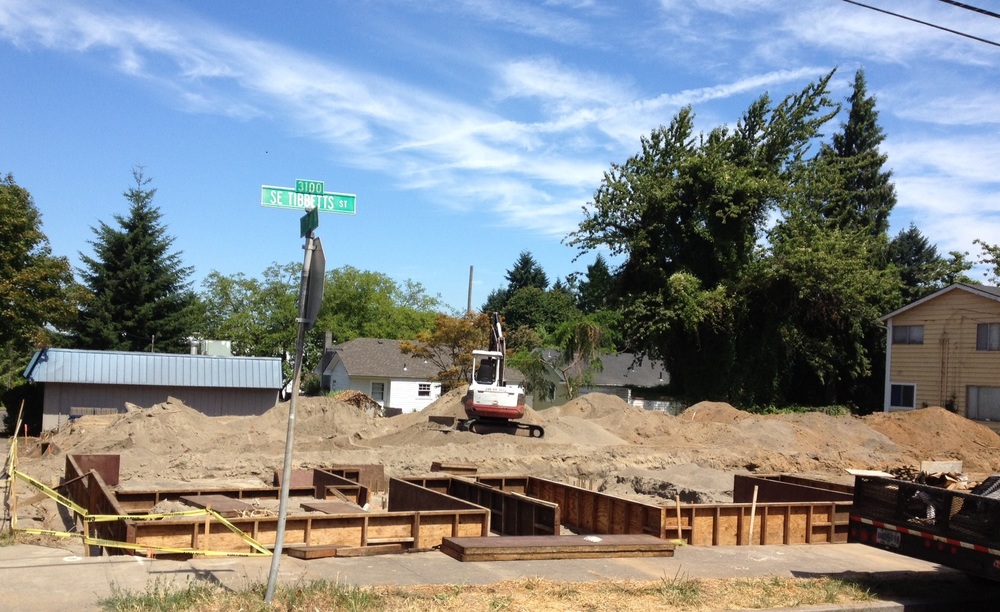
Ground has been broken, foundations are being laid, and soon, 12 townhouse style condominiums and their inhabiters will call the corner of SE 50th and Tibbetts home. Stay tuned for continuous updates.



 they drive up to your home and the landscaping is nicely manicured, the walkway is clean, there are welcoming potted plants at the front door, the door itself is inviting, the windows are clean, the exterior paint is in great condition, perhaps there are even a couple of nice chairs or a porch swing (if applicable), it will create a positive first impression. Remember you are just trying to set the stage that tells the potential buyer this is a quality home and a lot of care has gone into it.
they drive up to your home and the landscaping is nicely manicured, the walkway is clean, there are welcoming potted plants at the front door, the door itself is inviting, the windows are clean, the exterior paint is in great condition, perhaps there are even a couple of nice chairs or a porch swing (if applicable), it will create a positive first impression. Remember you are just trying to set the stage that tells the potential buyer this is a quality home and a lot of care has gone into it.
 important for building on that first impression. Take extra care to make this space as warm and inviting as possible. Also, notice the scent of your home when you enter the front door (this is especially important if you have a pet). A nice scent helps create an inviting atmosphere that works on a subconscious level with the prospective buyer. Nothing will dissuade a buyer faster than “house-a-tosis”. It’s important to correct the odor instead of covering it up if it’s due to mold or carpet damage caused by pets, etc. Stay away from heavy perfume scents or anything overbearing. Freshly cut flowers in the entry and throughout the house can provide some natural scent and add extra beauty and warmth to your home.
important for building on that first impression. Take extra care to make this space as warm and inviting as possible. Also, notice the scent of your home when you enter the front door (this is especially important if you have a pet). A nice scent helps create an inviting atmosphere that works on a subconscious level with the prospective buyer. Nothing will dissuade a buyer faster than “house-a-tosis”. It’s important to correct the odor instead of covering it up if it’s due to mold or carpet damage caused by pets, etc. Stay away from heavy perfume scents or anything overbearing. Freshly cut flowers in the entry and throughout the house can provide some natural scent and add extra beauty and warmth to your home. collection of widgets, but a prospective buyer might be distracted by all of the clutter. You want the buyer to look carefully at your home, not your possessions. A good rule-of-thumb is if it’s smaller than a grapefruit, pack it up. Remove any countertop appliances that are not built-in. Your furniture and accessories should help them get a sense of the space in the room and allow them to envision moving their own things in. Consider removing your personal photographs and memorabilia. You want buyers to envision creating their own memories in your home, not distracted by yours. Closets, basements, attics and garages should be clean, well-lit and organized. Ample storage is a common buyer request so make yours appear as spacious as possible. Do not make the mistake of moving the clutter from the living spaces to these areas. A temporary storage unit might be well worth the investment while your home is on the market. Plus you are moving, so consider the packing process underway!
collection of widgets, but a prospective buyer might be distracted by all of the clutter. You want the buyer to look carefully at your home, not your possessions. A good rule-of-thumb is if it’s smaller than a grapefruit, pack it up. Remove any countertop appliances that are not built-in. Your furniture and accessories should help them get a sense of the space in the room and allow them to envision moving their own things in. Consider removing your personal photographs and memorabilia. You want buyers to envision creating their own memories in your home, not distracted by yours. Closets, basements, attics and garages should be clean, well-lit and organized. Ample storage is a common buyer request so make yours appear as spacious as possible. Do not make the mistake of moving the clutter from the living spaces to these areas. A temporary storage unit might be well worth the investment while your home is on the market. Plus you are moving, so consider the packing process underway! Look at every surface: floors, walls, doors, windows, ceilings, built-in furniture, etc. Also make sure that all of your home’s systems are in good working condition (electrical, mechanical & plumbing).
Look at every surface: floors, walls, doors, windows, ceilings, built-in furniture, etc. Also make sure that all of your home’s systems are in good working condition (electrical, mechanical & plumbing). you are trying to appeal to the masses so if your home is decorated in a way that only a select few can appreciate, change it. Don’t remodel – it’s amazing what a fresh coat of neutral paint and simplifying and rearranging your current possessions will do. A few new accessories like fluffy new bath towels, accent pillows and fresh flowers might just add the finishing touches. Also, if your house is on the dark side then purchasing some extra lamps or using LED bulbs will be money well spent.
you are trying to appeal to the masses so if your home is decorated in a way that only a select few can appreciate, change it. Don’t remodel – it’s amazing what a fresh coat of neutral paint and simplifying and rearranging your current possessions will do. A few new accessories like fluffy new bath towels, accent pillows and fresh flowers might just add the finishing touches. Also, if your house is on the dark side then purchasing some extra lamps or using LED bulbs will be money well spent. all the clutter removal, repairs, and improvements. This is money well spent and will put the final polish on your “show ready” home. And don’t forget the windows!
all the clutter removal, repairs, and improvements. This is money well spent and will put the final polish on your “show ready” home. And don’t forget the windows!








.jpg)



.jpg)


.JPG 1000w, https://www.inhabitre.com/wp-content/uploads/2013/09/photo%20(3)-300x225.jpg 300w, https://www.inhabitre.com/wp-content/uploads/2013/09/photo%20(3)-768x576.jpg 768w)
